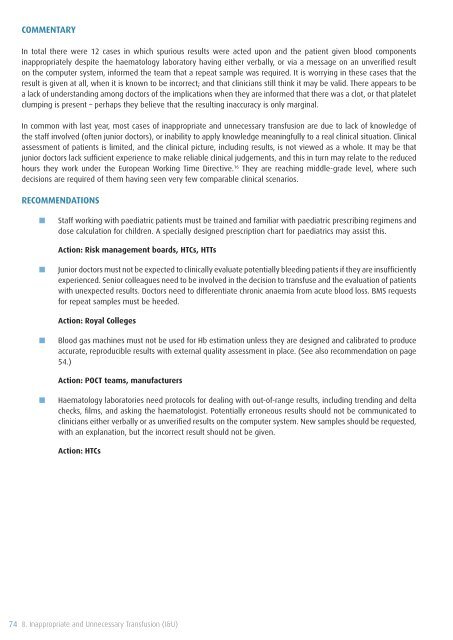SHOT Annual Report 2009 - Serious Hazards of Transfusion
SHOT Annual Report 2009 - Serious Hazards of Transfusion
SHOT Annual Report 2009 - Serious Hazards of Transfusion
Create successful ePaper yourself
Turn your PDF publications into a flip-book with our unique Google optimized e-Paper software.
COMMENTARY<br />
In total there were 12 cases in which spurious results were acted upon and the patient given blood components<br />
inappropriately despite the haematology laboratory having either verbally, or via a message on an unverified result<br />
on the computer system, informed the team that a repeat sample was required. It is worrying in these cases that the<br />
result is given at all, when it is known to be incorrect; and that clinicians still think it may be valid. There appears to be<br />
a lack <strong>of</strong> understanding among doctors <strong>of</strong> the implications when they are informed that there was a clot, or that platelet<br />
clumping is present – perhaps they believe that the resulting inaccuracy is only marginal.<br />
In common with last year, most cases <strong>of</strong> inappropriate and unnecessary transfusion are due to lack <strong>of</strong> knowledge <strong>of</strong><br />
the staff involved (<strong>of</strong>ten junior doctors), or inability to apply knowledge meaningfully to a real clinical situation. Clinical<br />
assessment <strong>of</strong> patients is limited, and the clinical picture, including results, is not viewed as a whole. It may be that<br />
junior doctors lack sufficient experience to make reliable clinical judgements, and this in turn may relate to the reduced<br />
hours they work under the European Working Time Directive. 16 They are reaching middle-grade level, where such<br />
decisions are required <strong>of</strong> them having seen very few comparable clinical scenarios.<br />
RECOMMENDATIONS<br />
■■<br />
Staff working with paediatric patients must be trained and familiar with paediatric prescribing regimens and<br />
dose calculation for children. A specially designed prescription chart for paediatrics may assist this.<br />
Action: Risk management boards, HTCs, HTTs<br />
■■<br />
Junior doctors must not be expected to clinically evaluate potentially bleeding patients if they are insufficiently<br />
experienced. Senior colleagues need to be involved in the decision to transfuse and the evaluation <strong>of</strong> patients<br />
with unexpected results. Doctors need to differentiate chronic anaemia from acute blood loss. BMS requests<br />
for repeat samples must be heeded.<br />
Action: Royal Colleges<br />
■■<br />
Blood gas machines must not be used for Hb estimation unless they are designed and calibrated to produce<br />
accurate, reproducible results with external quality assessment in place. (See also recommendation on page<br />
54.)<br />
Action: POCT teams, manufacturers<br />
■■<br />
Haematology laboratories need protocols for dealing with out-<strong>of</strong>-range results, including trending and delta<br />
checks, films, and asking the haematologist. Potentially erroneous results should not be communicated to<br />
clinicians either verbally or as unverified results on the computer system. New samples should be requested,<br />
with an explanation, but the incorrect result should not be given.<br />
Action: HTCs<br />
74 8. Inappropriate and Unnecessary <strong>Transfusion</strong> (I&U)












